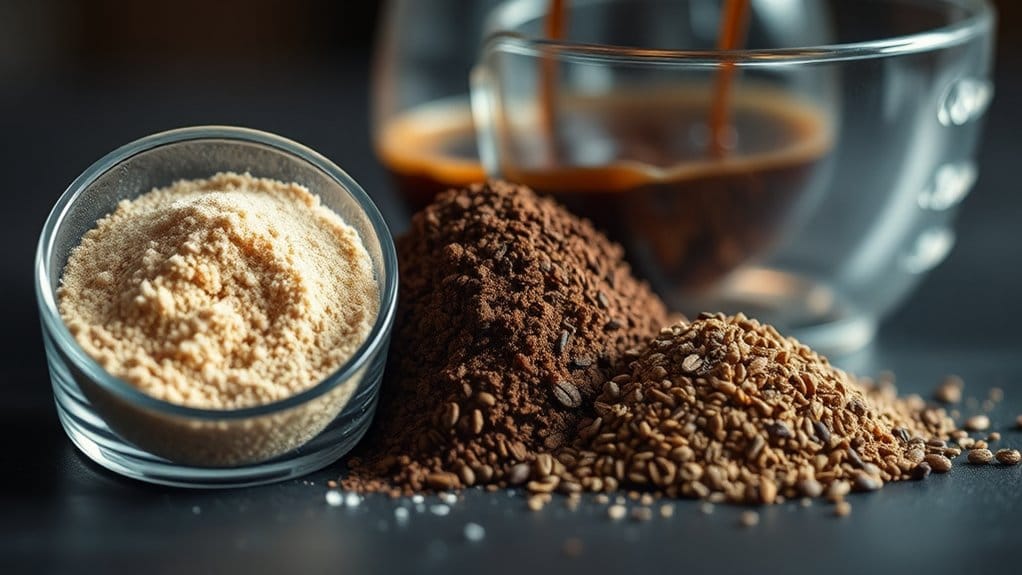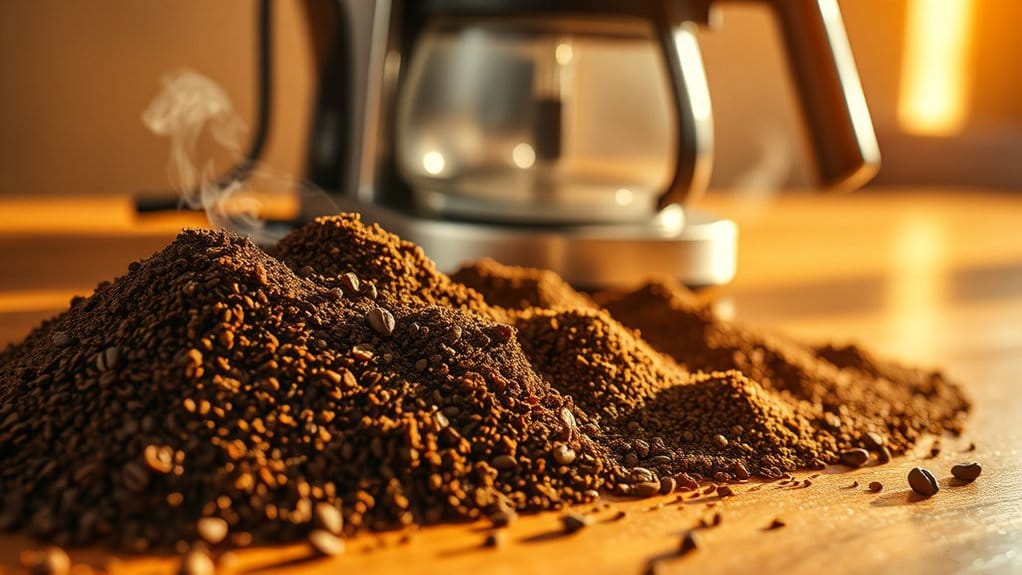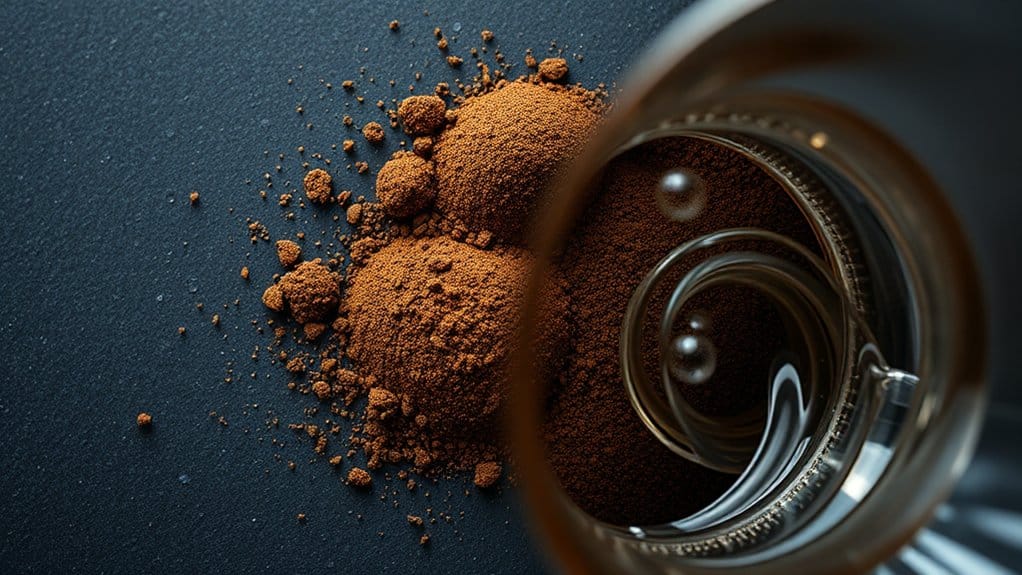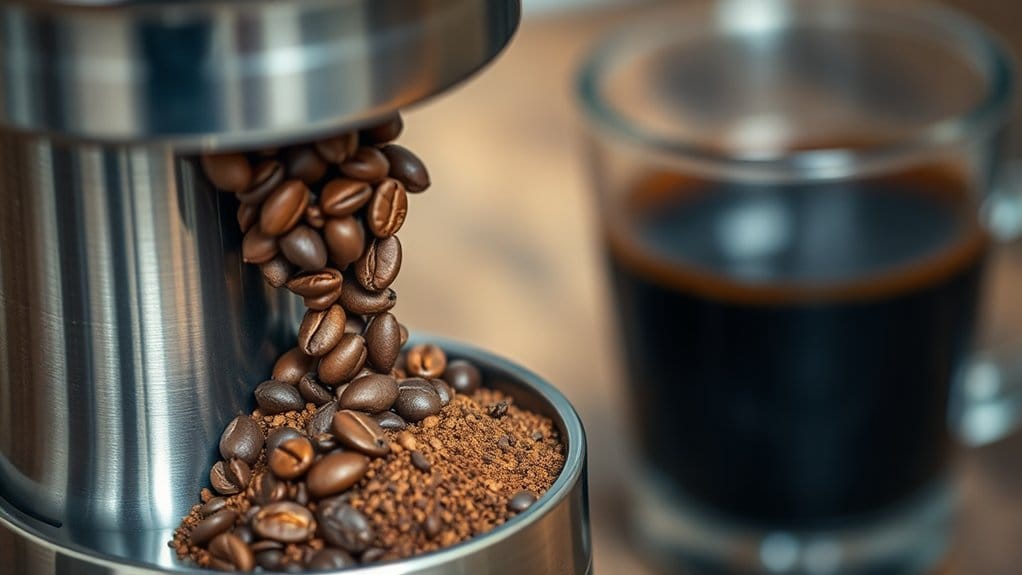Physical Address
304 North Cardinal St.
Dorchester Center, MA 02124
Physical Address
304 North Cardinal St.
Dorchester Center, MA 02124

Grind size affects extraction quality since it directly influences flavor release in your coffee. Finer grinds, like powdered sugar, can brew quickly, but they may likewise bring bitterness if over-extracted. Coarser grinds take longer and yield lighter tastes, but they can lose acidity. Think of it as baking: the right flour consistency makes a delicious cake! By experimenting with different grind sizes, you can find the perfect brew for your taste buds, so let’s investigate more about this fascinating topic!

When you brew coffee, did you ever stop to think about how grind size impacts extraction time? It’s actually pretty fascinating!
Coarser grinds, for instance, have larger particles with less surface area. That means they need more time—think 3 to 4 minutes—to let the water work its magic. You wouldn’t want to rush it, right? Uniform particle size is essential for understanding how extraction dynamics come into play with these coarser grinds. Additionally, the total dissolved solids (TDS) measurement will help you identify the optimal brewing parameters for each grind size. This is crucial, as incorrect grind sizes can lead to either over-extraction or under-extraction, compromising the final taste.
On the flip side, fine grinds offer a bigger surface area, speeding up that extraction. But if you’re not careful, you’ll end up with bitterness in your cup. Espresso is the perfect example—only 25 to 40 seconds for a strong shot!
Grind size plays a crucial role in how evenly your coffee extracts, so getting it right can make a world of difference in your cup.
When your coffee grounds are uniform, water flows through them evenly, soaking up all those delicious flavors. But go too fine, and you might face an unsavory showdown between bitter and sour tastes. Finer grounds increase surface area, usually a good thing, but they can lead to channeling, causing uneven extraction. Additionally, uniformity in grind size is critical for achieving consistent flavor extraction. Using the right grind size for your preferred brewing method ensures optimal extraction speed. Understanding how grind size influences flavor profile can help refine your espresso experience.
Conversely, irregular sizes create a wild party, where some bits get overcooked whereas others stay underdone.
Invest in a quality burr grinder to level up your game, and watch your coffee transform into a flavorful masterpiece. Who knew grind size could be so exciting?

Though you might think that coffee brewing is all about the right grind size, the truth is that particle size distribution (PSD) and bed packing take center stage in your coffee experience.
Think about it: when grounds settle, their arrangement can really change how water flows through them. A uniform bed made of mostly similar-sized particles lets water flow evenly. This is crucial because consistent particle sizes ensure even extraction, leading to balanced flavor clarity. Additionally, achieving a proper coffee-to-water ratio can enhance the overall flavor profile.
But if you’ve got a mix of fine and coarse particles, channeling happens, which means some coffee gets left behind. You wouldn’t want your coffee to be a gamble, right?
Managing fine particles helps maintain a good balance. So, next time you brew, keep in mind that both PSD and how those particles pack together matter just as much as the grind size!
The magic of coffee isn’t just in the beans you choose; it’s furthermore deeply rooted in how you grind them.
When you grind your beans finely, you’re releasing a cache of flavors. That’s due to finer grinds providing more surface area for water during brewing, allowing for richer aromas and complex tastes. But, beware—if your grind’s too fine, you risk bitterness and astringency, spoiling your perfect cup.
With coarser grinds, you often get a lighter, cleaner taste, though it can lack bright acidity. Think of it like cooking: a little salt improves flavor, but too much ruins the dish.
Experiment; find the balance between grind size and your favorite beans, as achieving optimal extraction is key to enhancing your coffee experience. After all, coffee is a delightful rhythm of chemistry!

When you’re ready to brew that perfect cup of coffee, a few practical tips can help you optimize your process.
Start by matching the grind size with your brewing method. For espresso, go fine, whereas French press calls for coarse grounds. Remember, longer brew times need coarser grinds to avoid that bitter taste we all dread.
If you’re using a pour-over, aim for medium-fine to let the water flow nicely.
Additionally, keep your grinder calibrated—nothing’s worse than inconsistent coffee! Don’t hesitate to experiment with different grind sizes based on your beans and taste preferences.
It’s also essential to consider the optimal flavor that freshly roasted African coffee beans can deliver, enhancing your brewing experience.
It’s all about finding that “sweet spot” to release the best flavors.
Happy brewing!
Understanding grind size limits isn’t just a science; it’s an adventure in coffee brewing!
When you delve into grind size, you’re really investigating how surface area affects extraction. Finer grinds can mean better extraction, but they might clog your coffee maker, leading to a bitter brew. Imagine this: if your burr grinder isn’t aligned just right, your coffee can taste uneven, like a rollercoaster ride gone wrong!
Experiment with different grind sizes, and you’ll notice coarser grinds need more time, whereas finer ones might brew too quickly and cause weird flavors. Consistent grind size is key, just like trying to bake the perfect cake.
Grind size impacts your coffee’s caffeine content considerably. Finer grinds expose more surface area to water, allowing for higher caffeine extraction, whereas coarser grinds limit this, resulting in lower caffeine levels in your brew.
You can measure grind size accurately using digital microscopes for high-resolution images, sieves for classification, laser diffraction analyzers for precise data, or smartphone apps for convenient visual estimates. Each tool offers unique benefits for assessment.
Yes, grind size can definitely affect your coffee’s acidity. Finer grinds extract acids more quickly, often resulting in higher acidity, whereas coarser grinds slow extraction, leading to a smoother, less acidic flavor profile.
During brewing, you’ll find that higher temperatures with fine grinds accelerate extraction, potentially causing bitterness. Conversely, coarser grinds at lower temperatures slow extraction, which may result in weak or underwhelming flavors in your coffee.
You might adjust grind size too drastically or inconsistently, overlook other brewing factors, or misuse grinder settings. These common mistakes lead to uneven extraction and unhappiness with your coffee’s flavor and overall quality.